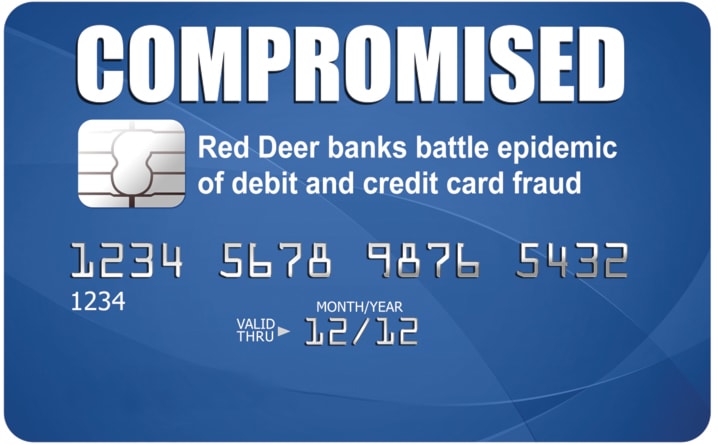Brittney Neufeld thought her accounts were more secure after acquiring her new debit chip card from her bank provider on Sunday.
She thought wrong.
Only a day later, the Red Deer woman’s account was frozen and a sinking suspicion was confirmed: Her card had been compromised.
When Neufeld, 24, went to her bank, ATB Financial, over lunch on Monday, she was told that she one of about 20 other people who had their cards compromised just that day.
Luckily, the bank caught the fraudulent activity before her account was drained.
RCMP have referred to this activity as “card skimming.” And even though more banks have turned to credit and debit cards with chip and personal identification number (PIN) technology, which supposedly has added security features, the problems continue to happen.
Cpl. Kathe DeHeer of the Red Deer City RCMP said a substantial amount of money is lost every year due to card skimming.
“It is very prevalent and people should be mindful that it is in Red Deer, it’s everywhere,” she said.
More than 89 per cent of credit card or ATM fraud is related to organized crime in Canada, DeHeer said. In 2009, $45.7 million was lost to credit and debit card fraud.
Card skimming happens when a business has its debit or credit card reader or point-of-sale terminal switched with one containing Bluetooth technology. The technology records the information, including the consumer’s PIN, DeHeer said.
She said, for example, that a group of people will fly out from Toronto, come to Red Deer and install “a whole pile” of skimming devices and leave a day later.
“Then it’s a couple of days before people notice something is amiss and they are gone,” she said.
Neufeld asked her bank how she could find out where her card was compromised and was told she needed to make file with the local RCMP.
“The bank asked me ‘Why do you want to know if no money was taken out of your account?’ and I said I want to know where it happened so I don’t go there again.
“But it was like, here is your new card, done,” Neufeld said of her experience with her bank.
Stefanie Couture, 26, of Red Deer, also had problems with her chip debit card.
Her chequing account with RBC Royal Bank was drained of over $1,000 about a month ago.
“I woke up one morning and my account was empty so I went online and went to the bank,” she said.
She said that the bank denied that card skimming or fraudulent activity was behind her loss and that she was responsible for it.
“I was sleeping, my card didn’t get stolen, no one has my PIN number but they think that I did it. I swear to God I didn’t,” she said. “They made me feel like I was the criminal.”
Much like Neufeld, the bank wouldn’t divulge to Couture where the transaction was made. That’s when she contacted the RCMP.
She said the RCMP told her that her account was accessed through four different ATMs, one in Red Deer and the other three in London, Ont., and Hamilton.
“What frustrated me the most is I was honest the whole time and I was turned into a criminal. Someone is good at what they do and they stole my money,” Couture said.
DeHeer said most banks have a limited time window for clients to report fraudulent activity.
“Say something happened with your money and you report it six weeks later, I believe banks have a limited amount of time that you can report it,” she said.
She said the best way for consumers to reduce their card skimming risk is by keeping apprised of their account activity and by keeping close tabs on their cards.
“The days of handing a waitress your card at the bar and having her walk away with it should be gone,” she said.
DeHeer encourages people to report any loss to police, saying that many will only report the scam to their banks.
“It is important for us to know.”
Clients of CIBC, Scotia Bank, Servus Credit Union and a northeastern Alberta credit union branch also made mention of their cards being tampered with recently.
Rachel Siednicki, manager of media relations with the Canadian Bankers Association, said that most Canadian banks are moving to chip cards for debit and credit transactions.
“These cards are embedded with a micro chip that will process transactions and the information on the chip is secure,” she said via email.
While the association says using debit cards is “very safe, with more than 99 per cent of the four billion transactions occurring without incident each year in Canada,” it does suggest ways that consumers can protect themselves.
• Always protect your PIN. Use your shoulder or your hand to shield your PIN.
• If you have a chip card, always insert first instead of swiping when making a purchase.
• Never lend your card or disclose your PIN to anyone else.
• Memorize your PIN; don’t write it down.
• Make sure your PIN can not be easily detected if your card is lost or stolen — don’t use your birth date or address or part of your telephone number.
• Consumers should regularly change their pin.
• Inspect the ATM or debit or credit card reader. Does it look right? Give the ATM a shake to see if the key pad is loose.
• Business owners or managers should inspect ATM or debit and credit card readers daily. All units have serial numbers that should be checked and recorded.
• Where possible, use a cash machine that is in clear view and is well lit.
• Card skimming is more prevalent at drive-throughs.
• Visit www.antifraudcentre-centreantifraude.ca for more information.
jjones@www.reddeeradvocate.com
